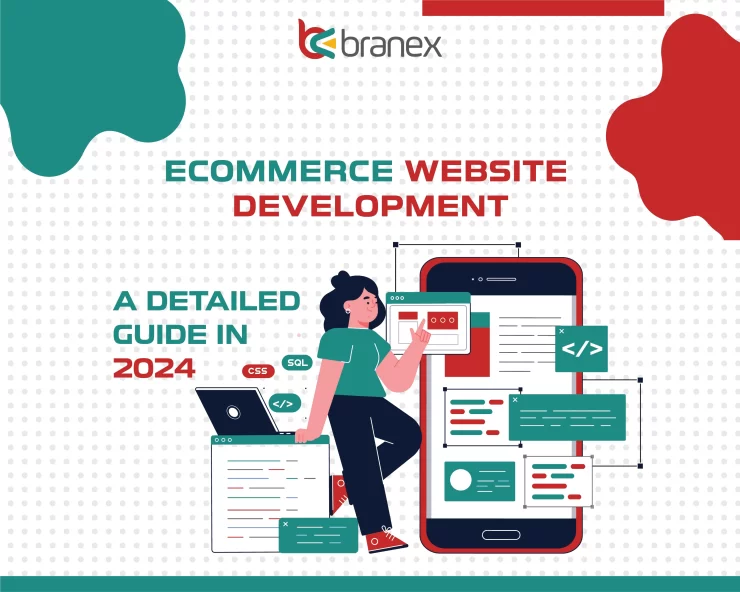Imagine walking into a crowded mall with over 24 million stores (that’s online stores!). Standing out in this online heavily crowded space can be tough. But your secret weapon? An amazing eCommerce website experience that keeps customers coming back. While online stores handle payments and stuff, they’re about much more than just selling.
Think sleek design, easy navigation, and security that makes grandma comfortable. Sounds complicated? Don’t worry!
Building an Ecommerce Store in 2024 – Essentials to Keep in Mind
This guide will explain custom eCommerce development, helping you understand and find the best place to build your dream online store.
Get ready to ditch the confusion and unlock your ecommerce success!
Define the Objective of Your Ecommerce Website’s Purpose
Forget crowded malls and waiting in line! E-commerce businesses offer a convenient way to shop for anything you need, right from your computer or phone.

Think of it as your own personal virtual mall, packed with a vast selection of products like clothing, electronics, groceries, and even pet supplies.
From household essentials to hobbies and crafts, you’ll find it all in one place.
The internet is booming with new businesses every day, making it easier than ever, to find what you want, when you want it. That’s the beauty of online shopping!
But before you dive in, let’s get you started on the right foot. The first step is figuring out what your online store is all about.
Ask yourself:
- What’s your vision? Where do you see your business in 3-5 years? Are you aiming for explosive growth, niche domination, or building a loyal community around your unique products?
- What problem are you solving for your customers? Are you simplifying their lives with convenient access to essential items, or offering something truly special and worthwhile?
By defining your goals and understanding your customer’s needs, you’ll lay the foundation for a successful online venture.
Do Your Keyword Research
With your vision and mission defined, it’s time to unlock the power of keywords!

The ultimate dream – dominating search results and driving customers to your online store. To make that dream a reality, keyword research is highly important.
Remember, it’s not just about chasing “top products“. The secret lies in low-volume, long-tail keywords that deliver targeted traffic and boost sales.
While Google Keyword Planner is a valuable tool, don’t neglect other gems like Ahrefs, SEMrush, and UberSuggest. These tools help you uncover hidden keywords that can propel your ranking faster than you think.
But hold on! Remember Google’s ever-evolving algorithm? It now prioritizes content semantics, search intent, and topical relevance. Keyword research has adapted to this shift.
Here’s the key:
- Go beyond just keywords. Understand the search intent behind them. Are users looking to buy, learn, or compare? Targeting the right intent is key to attracting the right customers.
- Think semantically. Don’t just stuff keywords in – create content that naturally flows and uses relevant synonyms and related terms. This signals relevance to search engines and users alike.
- Embrace long-tail keywords. While less competitive, they attract highly targeted customers ready to convert. Think “best vegan leather hiking boots for women” instead of just “boots”.
By mastering this new approach to keyword research, you’ll unlock the true potential of your online store and outrun the competition.
What is Semantic SEO Marketing?
Semantic SEO is a user-focused marketing strategy that boosts website visits by using clear metadata and content that directly reaches what people are searching for.
It goes beyond individual keywords and instead organizes content based on topics and related concepts, making it easier for search engines to understand the context and recommend relevant pages to users.
Think of it like a well-organized library where information is grouped by themes, making it easier for visitors to find exactly what they need quickly.
For example, an eCommerce site employing Semantic SEO might have a pillar page on ‘running shoes‘ with cluster content pages focusing on different types of running shoes for specific user needs (marathon, trail, casual).
This topical organization not only helps users visit the site easily but also signals to search engines the depth and expertise of the content, leading to higher rankings and increased organic traffic.
The Secret to Successful Keyword Research on Ecommerce Website
The secret to successful keyword research is Semantic SEO. Modern keyword research is all about searching terms based on user intent. So first things first, if you’re planning to start an e-commerce website, begin with identifying and meeting searcher’s intent for a given keyword. Your content will more likely rank higher in the SERPs (Search Engine Result Pages) if it engages potential customers. Our four-step process will show you how to make it happen:
- Step # 1: Avoid common keyword research mistakes that have been rooted in past techniques; avoid the ones that no longer work for you.
- Step # 2: Make use of intent marketing to drive better rankings so you can bring more organic traffic.
- Step # 3: Select the best keywords for your eCommerce website content.
In the past, relying solely on keyword volume for keyword research was common, but today, a more nuanced approach considering user intent and search engine algorithms is necessary.
Why Google’s Algorithm Started Prioritizing Search Intent?

Back in the day, keyword placement and placing backlinks would be the primary focus of Google’s algorithm. They are still an important aspect of SEO but there’s more to it than before…
People started realizing how keywords and backlinks are being abused and so did the machine learning algorithm behind Google. Such spammy practices like keyword stuffing & bulk buying of low-quality backlinks for websites offered little to no real value.
As a result, unhelpful and useless content took center stage and low-quality content started appearing more on the SERPs. It became quite contradictory to Google’s universal goal of bringing useful content to searchers.
Therefore, Google released several updates to improve its algorithm;
Panda Update (2011):
Aiming to combat manipulative SEO tactics, particularly the mass production of low-quality content by “content farms“, the Panda update launched in 2011. It shifted the ranking algorithm to favor unique, high-quality content that offered genuine value to users. Panda penalized websites with:
- Thin content: pages lacking substantial information or depth.
- Duplicate content: content copied from other sources without adding value.
- Low user engagement: websites with high bounce rates, limited time spent on page, and minimal user interaction.
By rewarding user-friendly content, Panda ushered in a new era of SEO emphasizing quality over quantity.
Penguin Update (2012):
Targeting manipulative “link building” practices, the Penguin update launched in 2012 analyzed website backlink profiles. It aimed to identify and devalue spammy backlinks from low-quality or irrelevant websites while recognizing and rewarding backlinks from authoritative sources. Penguin encouraged a natural approach to link building, focusing on acquiring links from credible and relevant websites in the same niche or with a clear connection to your content.
Moreover, Google introduced the “disavow tool” allowing website owners to report bad backlinks they cannot directly remove. This tool helped websites recover from negative impacts stemming from manipulative link-building strategies.
Hummingbird Update (2013):
Marking a more significant shift in search understanding, the Hummingbird update launched in 2013 focused on interpreting user intent. Moving beyond keyword matching, Hummingbird aimed to grasp the context and purpose behind a search query. This update enabled Google to:
- Analyze and rank content based on topics, including subtopics and synonyms, rather than just exact-match keywords.
- Understand the connection between entities within a search query, identifying relevant results even if keywords used directly don’t appear on the page.
By prioritizing search intent, Hummingbird revolutionized SEO, urging websites to create content aligned with what users truly seek and answer their questions directly, not just match specific keywords. The Hummingbird update (2013) was a pivotal moment in keyword research, marking a shift from exact-match keywords to understanding user intent and context.
However, several other significant updates further transformed the keyword research landscape:
RankBrain (2015):
Introduced machine learning to interpret complex and long-tail searches, understanding nuance and relationships between words and entities. This emphasized creating content that aligns with natural user queries, going beyond just individual keywords.
BERT (2019):
Further advanced natural language processing capabilities, allow Google to understand even more complex and conversational search queries. This pushed keyword research toward identifying user pain points, interests, and motivations, rather than focusing solely on specific keywords.
Passage Ranking (2020):
Prioritized ranking of individual passages within web pages relevant to specific search queries, even if the keyword might not be present on the entire page. This encouraged creating content with specific answers and information distributed throughout the text.
MUM (Multimodal Unification Model) (2021):
Announced, but not fully implemented yet, MUM promises to understand different information formats like text, images, and videos together. This implies the need for comprehensive content strategies that encompass various media formats to cater to diverse user needs and search intentions.
Core Web Vitals Update (2023):
While not directly related to keyword research, this update emphasizes page experience factors like loading speed, mobile-friendliness, and visual stability. It moved the direction from creating content that was well optimized for both, user experience as well as satisfying the user search intent.
Eventually, it summed up to;
“Today, Google encourages “covering every topic in depth and detail” not just for keywords, but to truly address user needs, provide comprehensive information, and deliver an excellent user experience. This involves understanding searcher intent, creating high-quality content, and optimizing for various content formats. It’s about meeting users where they are, with the information they truly seek, not just matching specific keywords.”
Branex 5-Step Strategy to Implementing Best Keyword Research Practices
Find a Domain Name and Relevant Hosting Service

The next step is to find a fitting eCommerce website domain name. Finding the best domain name can often feel like searching for a needle in the haystack. However, with the right keyword research & resources, you can easily find an eye-catching choice that meets the current business trends. A few tips to find the perfect domain name and relevant hosting are:
Check Domain Trends:
Search up what other businesses within the industry are doing. See if there are any emerging keywords or themes that you could try incorporating within your domain name.
Use a Domain Generator Tool:
If you can’t come up with ideas yourself, you can always make use of a domain generator tool. Such tools are great for quickly generating ideas & eliminating associated stresses.
Once you have come up with a suitable domain name that suits your preference, the next step is to set up web hosting for your eCommerce website. The Internet is full of many web hosting service providers; it’s important to thoroughly evaluate options & find one that meets your business needs. A few things that you need to pay attention to are:
- The level of customer support offered
- Security features
- Pricing
- Platform compatibility
Finding the right domain name and web hosting for your eCommerce website can be a time-consuming process. But, once you’ve found the right one, your digital store can go live.
Choosing the Right Platform for Your Ecommerce Website
eCommerce has come a long way and using an eCommerce platform can be daunting. Making the wrong decision can often leave you with a website that’s broken and full of errors.
After all, you don’t want to go to and fro your website.
When you make the wrong decision, it can be catastrophic for your overall business.
Ecommerce website development platform selection can be a complex process as there are a lot of technologies out there. Selecting the right one should be at the top of your list!
Here are a few things you need to consider when deciding the platform for your eCommerce website:
Ease of User & Functionality – The first factor to consider is the ease of use and functionality of the chosen platform. Does it have all of the features that you need to build a successful website? Such as integrated payment gateways and mobile responsive design. Does it have a user-friendly online store that is intuitive for your customers to use? And is your eCommerce website easy to manage once it’s up?
Support & Community – The second is to consider how to access support documentation, user groups, & training support. The support can come in many forms, including but not limited to online user groups, detailed support documents, social media groups, business forums, and more. Organizations take time to provide quality support which is often rewarded in the later stages of your business.
Scalability & Flexibility – Nowadays, customer experience is dependent on customization and expansion capabilities which are far-reaching. Understanding what your store offers is critical when choosing a platform that supports long-term growth. With careful consideration, you can create digital experiences that are enjoyable and worthwhile for shoppers, online visitors, and more.
Deciding Whether to Go For Custom Website Design vs Template
If you want more control over your eCommerce website design, you might want to go for a custom website design option instead of a template. If you’re low on budget and can’t afford to hire a designer, you may consider using a template or pre-built theme.
While choosing a website design, you should check on factors like website responsiveness, user interface design, SEO optimization, eCommerce functionality, advanced analytic tools & customizable templates. The choice of whether to use a custom design or template depends on these factors, regardless of whichever approach you choose for your next web design.
How Do You Know Custom Web Design is Right For You?
You may consider the following factors:
- Website responsiveness: Will your website be responsive on all devices, from desktops to smartphones?
- User interface design: Does your website offer an engaging experience that guides users towards desired actions?
- SEO optimization: Is your website built with search engines in mind, for maximum visibility?
- E-commerce functionality: Does your website include shopping features like product listings, checkout processes, and secure payment gateways?
- Advanced analytics tools: Can you track and analyze user behavior to understand what’s working and what’s not?
- Customizable templates: Do you need a unique design that reflects your brand identity and sets you apart from the competition?
If you answered “yes” to most of these questions, a custom website design might be the best investment for your e-commerce business. However, even if you’re on a tight budget, there are ways to achieve a high-quality eCommerce website look and feel.
Consider partnering with a UI/UX design agency that specializes in crafting user-centric e-commerce experiences. They can help you create a website that not only looks beautiful but also takes your business up a notch giving it a significant upscale.
Planning What Features You May Want in Your eCommerce Website?
There are several important features that your eCommerce website must have at all costs. If these features are not present, there’s a high chance your website might not perform as effectively as you think it may. Listed below are a few necessary options that you must include:
User-Friendly Navigation – One of the most important features of an eCommerce website is to be able to find products that you’re looking for. When the products are organized in proper categories, intuitive menus, and a powerful search function, it becomes easier for customers to navigate through different parts of the website.
High-Quality Product Pages – Another important feature that will make an eCommerce website standout is to find high-quality product images. Alongside images, it is also highly important to have detailed descriptions, zoom functionality, and customer reviews on their website.
Mobile Responsiveness – Just as much as high-quality website images are concerned, so are website looks and functionality. If your website doesn’t work effectively across all devices such as smartphones and tablets, you can experience roadblocks and your website or app may not perform as effectively across different devices as you expect it to.
Fast Loading Time – When it comes to the online shopping experience, nobody wants to spend time waiting for a website to load. Therefore, it is important to optimize your website, so it has a fast loading time and you do not avoid losing customers.
Security & Trust – Last but not least, securing a website is of the utmost importance. These may include practices such as implementing SSL certificates, applying for strong password protection, and clear privacy policies to build trust among customers.
Make Sure to Collect & Track Payments on Your eCommerce Website

For any eCommerce business to handle payments efficiently, it should support different merchant accounts and payment gateways.
While PayPal and Apple Pay are commonly considered quick payment processing services, there are many other renowned payment options that one can choose to easily handle small and large transactions not just locally but also internationally.
If you’re planning to launch your own eCommerce website, here are a few options that you should consider while setting up your eCommerce web.
- Stripe: A popular option for its ease of use and wide range of features, including recurring payments and subscription billing.
- PayPal: A well-known and trusted brand with a large user base. Less suitable for high-risk businesses.
- Amazon Pay: A good option if you sell on Amazon or want to reach Amazon’s customer base.
- Square: A good option for smaller businesses with simple payment needs.
- Authorize.Net: A popular option for larger businesses with more complex needs.
Many merchant accounts are already integrated with different CRM (customer relationship management) platforms which offer additional benefits like automatic tracking of billing data, keeping customer records up-to-date, and simplifying the acquisition of payment details.
Having the right payment gateway well-integrated with your eCommerce online presence will offer secured payments all the while keeping the transaction process simple & easy.
Picking the Right Type of eCommerce Shipping & Delivery
More than 50% of the people in the United States receive Amazon packages almost every week. With the rise of eCommerce, there are many third-party logistics providers which offer shipping and delivery. Services such as Amazon FBA, FedEx, and DHL are a few popular third-party providers worthy of consideration for businesses that are looking to optimize shipping & delivery platforms. To ensure your customers have a smooth customer experience, choosing the right type of eCommerce shipping & delivery becomes more than eminent.
No matter what third-party eCommerce shipping provider you select for your next eCommerce store, make sure to have an impactful strategy in place for efficient delivery.
Integrate the Correct Ecommerce Customer Support
Every successful e-commerce store needs robust customer support in place.
This includes a combination of best practices, such as a knowledge base, live chat support, phone support, FAQs, and AI-powered tools.
Here’s how you can ensure perfect customer service across different channels:
- Live chat apps: Make use of platforms like Facebook Messenger and WhatsApp to offer personalized and convenient experiences. Customers appreciate the real-time interaction, minimizing the need to wait on hold or for email replies.
- Phone support: Don’t underestimate the value of offering a phone line. This direct communication channel remains important for some customers, allowing them to address complex issues or simply prefer voice interaction. Make sure your representatives are equipped to handle concerns most effectively.
- Knowledge base: Create a comprehensive FAQ section or knowledge base. This lets customers find answers to common questions independently, reducing support load and saving everyone time.
- AI-powered tools: Consider implementing AI-powered chatbots to handle basic inquiries, freeing up human agents for more complex situations. Moreover, AI-powered shopping assistants can personalize product recommendations & answer product-related questions, improving the overall shopping experience.
To deliver exceptional customer support in your e-commerce business, blend creativity with best practices. This winning combination keeps your customers engaged & meet efficiently.
Traversing the crowded online marketplace can be daunting, but a user-friendly, secure, and well-optimized website is your secret weapon. This guide explores the process, equipping you with the knowledge and strategies to build a successful e-commerce store.
Here are the key takeaways to remember:
- Define your vision and target audience. What are you selling, and who are you selling it to? Understanding their needs and search intent is significant.
- Embrace “Semantic SEO” for effective keyword research. Focus on content that answers user questions and provides value, not just ranking for specific keywords.
- Choose the right platform based on your needs. Consider ease of use, functionality, scalability, and support before making a decision.
- Prioritize user experience with features like:
- Intuitive navigation and search
- High-quality product pages with detailed descriptions and images
- Mobile responsiveness for seamless browsing on any device
- Fast loading times to keep customers engaged
- Secure payment gateways and clear privacy policies
- Offer multiple payment options and integrate a reliable shipping & delivery service.
- Implement a robust customer support system including FAQs, live chat, phone support, and AI-powered tools to assist customers & answer their questions effectively.
Don’t forget! Creativity and best practices go hand-in-hand.
By implementing these strategies and adding your unique touch, you can build an e-commerce website that attracts customers, drives sales, and thrives in the online market.
Ready to Launch Your ECommerce Journey?
Branex, a custom website development company is here to help!
We offer comprehensive ecommerce development services and strategic SEO solutions to create a winning online store for your business.
Contact us today for a free consultation and let’s discuss how we can help you achieve your e-commerce goals.




